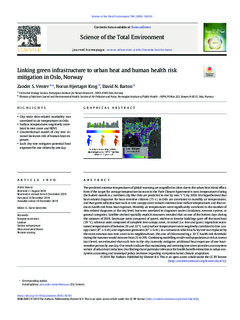| dc.contributor.author | Venter, Alexander Samuel | |
| dc.contributor.author | Krog, Norun Hjertager | |
| dc.contributor.author | Barton, David Nicholas | |
| dc.coverage.spatial | Oslo, Noreg, Norge, Norway | nb_NO |
| dc.date.accessioned | 2020-01-02T15:41:08Z | |
| dc.date.available | 2020-01-02T15:41:08Z | |
| dc.date.issued | 2019 | |
| dc.identifier.issn | 0048-9697 | |
| dc.identifier.uri | http://hdl.handle.net/11250/2634668 | |
| dc.description.abstract | The predicted extreme temperatures of globalwarming aremagnified in cities due to the urban heat island effect. Even if the target for average temperature increase in the Paris Climate Agreement is met, temperatures during the hottest month in a northern city like Oslo are predicted to rise by over 5 °C by 2050. We hypothesised that heat-related diagnoses for heat-sensitive citizens (75+) in Oslo are correlated to monthly air temperatures, and that green infrastructure such as tree canopy cover reduces extreme land surface temperatures and thus reduces health risk from heat exposure. Monthly air temperatures were significantly correlated to the number of skin-related diagnoses at the city level, but were unrelated to diagnoses under circulatory, nervous system, or general categories. Satellite-derived spatially-explicit measures revealed that on one of the hottest days during the summer of 2018, landscape units composed of paved, midrise or lowrise buildings gave off the most heat (39 °C), whereas units composed of complete tree canopy cover, ormixed (i.e. tree and grass) vegetation maintained temperatures of between 29 and 32 °C. Land surface temperatureswere negatively correlated to tree canopy cover (R2=0.45) and vegetation greenness (R2=0.41). In a scenario inwhich each city treewas replaced by the most common non-tree cover in its neighbourhood, the area of Oslo exceeding a 30 °C health risk threshold
during the summerwould increase from23 to 29%. Combiningmodelling resultswith population at risk at census tract level, we estimated that each tree in the city currently mitigates additional heat exposure of one heatsensitive person by one day. Our results indicate that maintaining and restoring tree cover provides an ecosystem service of urban heat reduction. Our findings have particular relevance for health benefit estimation in urban ecosystem accounting and municipal policy decisions regarding ecosystem-based climate adaptation. | nb_NO |
| dc.language.iso | eng | nb_NO |
| dc.rights | Navngivelse 4.0 Internasjonal | * |
| dc.rights.uri | http://creativecommons.org/licenses/by/4.0/deed.no | * |
| dc.subject | Ecosystem services | nb_NO |
| dc.subject | Landsat | nb_NO |
| dc.subject | Surface temperature | nb_NO |
| dc.subject | Heat-associated illness | nb_NO |
| dc.subject | Remote sensing | nb_NO |
| dc.title | Linking green infrastructure to urban heat and human health risk mitigation in Oslo, Norway | nb_NO |
| dc.type | Peer reviewed | nb_NO |
| dc.type | Journal article | |
| dc.description.version | publishedVersion | nb_NO |
| dc.rights.holder | © 2019 The Authors. | nb_NO |
| dc.subject.nsi | VDP::Samfunnsvitenskap: 200::Økonomi: 210 | nb_NO |
| dc.source.journal | Science of the Total Environment | nb_NO |
| dc.identifier.doi | 10.1016/j.scitotenv.2019.136193 | |
| dc.identifier.cristin | 1763487 | |

